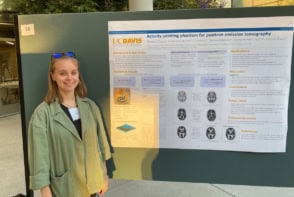
Cone-beam CT (CBCT) scanners offer the advantages of being compact in size, less costly, and more portable than multidetector CT systems. Image quality, however, is often impacted by artefacts such as streaking or shading, associated with cone-beam effects and/or nonuniformity in image quality near the ends of the field-of-view (FOV).
Research is underway to improve CBCT image quality. Biomedical engineers at Johns Hopkins University are working with collaborators in radiology and at Carestream Health to develop a multisource CBCT scanner dedicated for extremity imaging. The team has now demonstrated that the prototype research scanner reduced cone-beam artefacts over a single-source CBCT scanner and provided a larger longitudinal FOV (Med. Phys. 45 144).
Three-source configuration
The gantry enclosure of the scanner is a C-shaped, self-shielded carbon fibre hull enclosing the source and detector, enabling an arm or leg to be placed through a door within the “C”. The inner diameter of the gantry is 20 cm, and includes an expanded region for placement of a foot. The circular detector orbit extends to 210°, with the flat-panel X-ray detector (FPD) passing within the closed door during a scan. The source-to-axis distance is 40.4 cm, and the source-to-detector distance is 53.8 cm.
The scanner’s X-ray source consists of three separate anode-cathode units evenly distributed with 12.7 spacing along the longitudinal direction. Each anode-cathode axis is oriented along the longitudinal axes and angulated to present a focal spot at the centre of the detector. Each source has a separate primary collimator with three output windows on the X-ray tube housing, allowing each source to cover a large FOV at the FPD. The FPD was read in 2 x 2 binning mode at a pixel size of 0.278 mm, with a nominal readout rate of 25 frames per second.
Image protocol and acquisition

The researchers investigated the image quality and dose characteristics of the prototype scanner. For the study, they acquired images from both single-source and three-source configurations. The scan protocol for all acquisitions used 90 kV, 6 mA tube current and 20 ms pulse width for each source. A total of 600 projections (200 for each source) were acquired. They utilized a custom filtered back projection (FBP) algorithm for reconstruction, using a simple linear combination of the three single-source FBP reconstructions via a voxel-based weighting “map”. They also used a soft-tissue kernel to visualize soft-tissue details of muscle, cartilage, tendons and ligaments above the knee and joint space.
Senior author Jeffrey Siewerdsen and colleagues measured radiation dose using a Farmer chamber in three CTDI phantoms stacked end-to-end. They performed measurements at the central and four peripheral locations on the axial plane and along the longitudinal direction.
For visual assessment of cone-beam artefacts in the reconstructed images, the researchers used a modified Defrise phantom and anthropomorphic knee and hand phantoms. To characterize image performance, they focused on the uniformity, noise, noise-power spectrum (NPS) and cone-beam effects in 3D images reconstructed from the three-source configuration and the three individual sources.
Comparative findings
The dose distribution for the three-source configuration exhibited asymmetry due to both the short-scan geometry (radial asymmetry, in which dose was higher at the periphery closer to the X-ray source) and the multi-source arrangement (more uniform longitudinal dose distribution for the three-source configuration). The authors note that such asymmetric dose distributions are important to consider in rigorous dose characterization of this and other CBCT systems.
Sampling characteristics of the three-source configuration were superior overall. Areas of greatest reduction in noise and cone-beam artefacts were identified near the central plane of each X-ray source, increasing at locations intermediate to each source. The authors reported that this configuration demonstrated a more complete 3D sampling with an overall reduction in the “null cone” of unsampled frequencies.
Cone-beam/3D sampling effects in a modified Defrise phantom were also better overall. The three-source configuration exhibited high-fidelity reconstruction at the midplanes of the central, upper and lower sources. Its longer FOV (up to about 30 cm) offered better visualization of long-bone fractures. While cone-beam artefacts were visible in images acquired from both configurations, images for the three-source configuration were of superior quality, enabling clear visualization of joint spaces, cartilage and tendon.
“The multiple-source configuration appears particularly beneficial for imaging scenarios in which the anatomy contains high-contrast surfaces at large distance from the central axial plane and/or throughout the FOV, as with the hand, knee or foot,” wrote the authors. The system is now undergoing additional clinical studies of diagnostic performance and utility.



